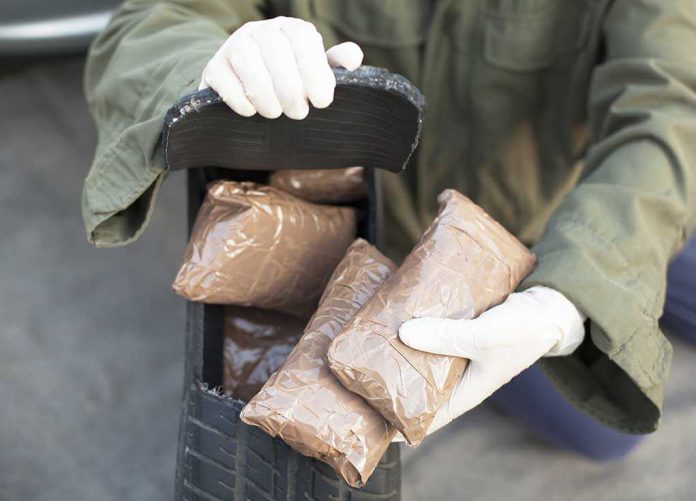
Drug cartels have unleashed a new threat on the high seas – Colombia just seized the first unmanned “narco-submarine” equipped with Starlink technology that could transport 1.5 tonnes of cocaine without a single human aboard.
Key Takeaways
- Colombia’s Navy seized its first unmanned narco-submarine equipped with Starlink satellite technology off its Caribbean coast
- The vessel was empty during seizure, indicating it was likely a test run by Colombia’s largest drug trafficking group, the Gulf Clan
- This unmanned submarine represents a dangerous evolution in drug trafficking technology, eliminating human operators who might cooperate with authorities if captured
- The vessel had the capacity to transport 1.5 tonnes of cocaine and is part of a record year for narco-submarine interceptions
- Cartels are increasingly employing sophisticated technology to evade detection, with some vessels now capable of crossing oceans
Cartel Technology Leaps Forward With Unmanned Drug Submarine
Colombian authorities have seized an unmanned submarine equipped with advanced Starlink satellite technology off the country’s Caribbean coast. This marks the first such discovery in South American waters and signals a dramatic technological advancement by drug cartels seeking new ways to transport cocaine without risking human operatives. Though the vessel was empty when intercepted, naval officials believe it was undergoing testing by Colombia’s Gulf Clan, the country’s largest drug trafficking organization, before being deployed for actual smuggling operations.
The Colombian navy on Wednesday announced its first seizure of an unmanned narco-submarine equipped with a Starlink antenna off its Caribbean coast https://t.co/bxuSLPbvjd
— Insider Paper (@TheInsiderPaper) July 2, 2025
The sophisticated vessel represents a concerning evolution in narcotics trafficking methods. With a capacity to transport approximately 1.5 tonnes of cocaine, this remotely operated submarine could deliver massive drug shipments while eliminating the risk of captured crew members providing information to authorities. This development comes amid a record year for narco-submarine interceptions, as cartels increasingly turn to maritime routes for moving their product to international markets.
Starlink Technology Enables Remote Control Drug Trafficking
The integration of Starlink satellite technology represents a significant tactical advancement for drug traffickers. The satellite antenna discovered on the vessel enables remote control capabilities and reliable communication even in open waters. Naval authorities are actively investigating exactly how the system operates, with initial findings suggesting the submarine could navigate with partial autonomy while maintaining contact with its operators. The Colombian Navy is particularly concerned about how this technology might be used to bypass traditional interdiction efforts.
“It was being tested and was empty,” a naval spokeswoman told reporters, confirming that authorities “had that technology” and were still studying precisely how the vessel operated.
This isn’t the first time Starlink technology has been employed by drug traffickers. Previous incidents have linked the satellite internet service to other trafficking operations, including a methamphetamine shipment near the Andaman and Nicobar islands. The technology provides traffickers with reliable communication in remote areas where traditional cellular networks are unavailable, making detection and interception significantly more difficult for law enforcement agencies.
Evolving Tactics in the War on Drugs
Naval officials note that Mexican drug cartels have been working on unmanned submarine technology since at least 2017. These efforts represent part of a broader shift toward sophisticated autonomous systems designed to evade detection while reducing human risk. Semi-submersible vessels have been used for decades to transport cocaine from Colombia to Central America or Mexico, but in recent years these craft have been traveling farther distances, even crossing oceans to reach Australia and Europe.
“Migration toward more sophisticated unmanned systems,” Admiral Juan Ricardo Rozo explained, highlighting the technological arms race between traffickers and law enforcement.
Colombian law imposes penalties of up to 14 years in prison for involvement with semi-submersibles, reflecting the seriousness with which the country views these trafficking methods. Yet despite these measures, cocaine production, seizures, and use all reached record highs in 2023, with Colombia’s production at unprecedented levels due to increasing global demand. President Trump has consistently highlighted the need for stronger border security to combat the flow of illegal drugs into America, which this technological advancement makes even more challenging.
A New Front in Border Security
The emergence of unmanned drug submarines represents a significant new challenge for U.S. border security and President Trump’s ongoing efforts to combat drug trafficking. These vessels can potentially deliver massive drug shipments directly to coastal areas with minimal risk of detection. The Colombian Navy’s seizure provides valuable intelligence about cartel capabilities but also raises concerns about how many similar vessels might already be operating undetected.
“Removing the crew eliminates the risk of captured operators cooperating with authorities,” noted Henry Shuldiner, security analyst, highlighting why cartels find this technology so appealing.
As cartels continue investing in advanced technologies, including drones, remote-controlled submarines, and satellite communications, the threat to America’s borders evolves. The unmanned nature of these vessels means traditional interdiction methods that rely on capturing and interrogating crew members become ineffective. This technological leap by drug traffickers underscores the need for equally advanced countermeasures and heightened vigilance along America’s maritime borders to prevent these sophisticated narco-submarines from delivering their deadly cargo to American shores.






